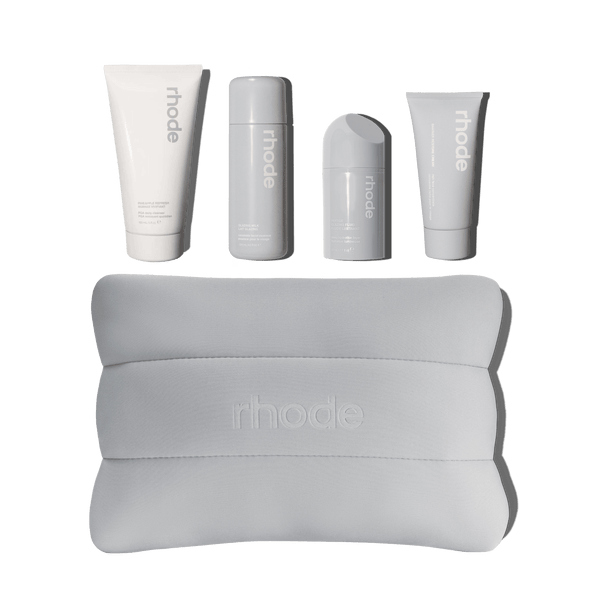For years, influencer marketing was about renting reach—a post, a story, a campaign, and then on to the next. But now it’s entered a whole new arena.
According to Goldman Sachs, the creator economy is on track to hit $480 billion by 2027—a clear signal of just how fast the creator space is scaling.
When Rhode, Hailey Bieber’s skincare brand, crossed the $1 billion valuation mark this year, it didn’t just make beauty headlines; it sent a message to the entire marketing world. Creator-led businesses have officially outgrown their reputation as side hustles. They are now acquirable, scalable, billion-dollar enterprises.
But Rhode’s milestone proves a new reality: influence is no longer just cultural currency or one-off campaigns but rather part of the bigger picture that’s business equity. The brands (and marketers) recognizing this shift first will be the ones positioned to build real, lasting value.
Credit: rhodeskin.com
From Hype to High-Value: Why This Moment Matters
Celebrity and creator ventures aren’t new.
A decade ago, most were licensing deals. The slapping of a famous name on fragrances, fashion lines, or fast beauty drops. These businesses were dependent on short-term attention, and few ever scaled into enduring brands.
Today, the landscape is different. The new wave of creator-led businesses is designed from the ground up with operational rigor.
Rhode’s billion-dollar valuation, Huda Beauty’s global reach, and SKIMS’ $4 billion valuation all prove that creator brands can compete head-to-head with legacy incumbents. And investors have noticed: acquisition multiples for creator-led brands are now on par with (or in some cases exceeding) those of traditional DTC startups.
This moment matters because it signals a shift in how influence translates into enterprise value.
What was once about visibility is now about viability. For CMOs, the implications are clear: creator partnerships must evolve from campaign-driven to equity-driven.
Trust and Community: The Creator Advantage
Creators have spent years building credibility with their audiences. Their recommendations feel personal, not transactional, and that authenticity drives conversion in ways traditional ads rarely can. Consumers today are wary of being sold to. But they lean into buying when it feels like the product is coming from someone they know and, more importantly, someone they trust.
This trust is coupled with a structural advantage.
Creators begin with a built-in audience. They don’t have to fight for early visibility or invest in costly acquisition campaigns. Their engaged communities are already primed to buy. That lowers customer acquisition costs dramatically and gives creator-led brands a head start that others often spend years (and millions) trying to achieve.
Consider Gothamista, a skincare influencer whose curated collaborations and limited-edition product drops consistently sell out. The demand doesn’t come from paid advertising; it comes from the credibility she’s earned within her community over the years. When Gothamista puts her name behind a product, her audience trusts it’s worth buying. That trust is a competitive moat no ad budget can replicate.
And the advantage doesn’t stop there.
The best Creators are natural storytellers. They know how to produce content that resonates, often blurring the line between entertainment and marketing. This means their product launches are fueled not just by media buys, but by organic, viral-ready storytelling that feels native to their audience.
Add in niche precision—where creators design products for hyper-specific communities—and you have businesses that feel personal and tailored, not generic. Pair that with their agility in responding to feedback and cultural shifts, and you get brands that are not only trusted but also nimble enough to stay relevant.
In short, creator-led brands win because they combine authenticity, built-in distribution, lower CAC, niche focus, and agility. Together, those forces explain why these businesses aren’t just scaling, but often outperforming their traditional competitors.
The Operational Playbook Behind Billion-Dollar Creator Brands
Of course, authenticity alone isn’t enough to secure billion-dollar valuations.
What separates creator-led brands that fizzle from those that scale is the operational backbone behind the personality.
The best examples marry creator credibility with enterprise-level infrastructure. Behind every viral launch is a disciplined system of supply chain logistics, compliance, retail partnerships, and leadership talent that ensures the brand can grow sustainably.
Take SKIMS, for instance. What began as a direct to consumer DTC shapewear brand now has a global retail presence and a valuation rivaling legacy apparel companies. That leap wasn’t powered by celebrity status alone; it was made possible by investing early in manufacturing, fulfillment, and international expansion.
This is the overlooked truth: the creator’s name might spark the fire, but infrastructure is what keeps the brand burning.
Investors understand this, which is why acquisition-ready creator brands are the ones that professionalize early by hiring experienced operators, securing reliable supply chains, and building systems that can scale far beyond one personality or platform.
Why the Funnel Comes First
One of the biggest mistakes brands make when jumping into creator partnerships is assuming that traffic equals growth. Driving attention without a system to capture, nurture, and convert it is a fast way to waste both money and momentum.
As Alex Lieberman puts it: “Creator marketers haven’t refined their marketing funnel before driving a ton of traffic with partnerships.” In other words, creators can spark awareness, but if your funnel isn’t designed to guide that attention into sales and long-term loyalty, the impact falls flat.
Before investing in creator campaigns, marketing leaders need to ensure their funnel is airtight—clear messaging at the top, seamless paths to conversion in the middle, and retention mechanisms at the bottom. When the funnel is strong, creator-led traffic doesn’t just create buzz. It compounds into brand equity, repeat purchases, and scalable growth.
.png?width=500&height=375&name=Soft%20Pink%20Minimalist%20Marketing%20Funnel%20Graph%20(1).png)
That’s the lesson: marketing can spark awareness, but lasting value requires operational readiness. The brands winning in this new landscape are built like startups, not side projects.
What Marketers Can Learn From Creator-Led Businesses
So what can CMOs and brand teams take away from this shift? The rise of creator-led brands is more than an interesting cultural moment; it’s more of a strategic roadmap.
- Durability over campaigns. One-off sponsorships generate reach. Long-term partnerships create equity. The smartest brands are moving toward co-owned products, ambassador programs, and shared upside.
- Co-creation over placement. Don’t just hand creators a script. Invite them into the process early, from product design to positioning. Their fingerprints increase buy-in and give the product cultural resonance.
- Community as currency. Reach is a vanity metric. Loyalty is the growth driver. Look at retention rates, repeat purchase potential, and cultural influence when evaluating creator partners.
- Structure behind the story. Campaigns may win impressions, but businesses win with infrastructure. Assess whether your creator partnerships and your own marketing org are built to scale.
These aren’t optional lessons. They’re the difference between keeping influencer marketing as a cost center and evolving it into a true driver of enterprise growth.
Clear Takeaways for Marketing Teams
To make this shift actionable, here are five practical moves marketing leaders can implement now:
- Rebalance your influencer spend. Shift budget away from one-off campaigns and into longer-term partnerships with creators who can deliver equity value.
- Experiment with ownership models. Test revenue-sharing, co-branding, or equity stakes. The future of creator marketing is partnership, not patronage.
- Build incubation programs. Don’t just borrow influence; co-create it. Develop sub-brands with creators in your category and leverage your infrastructure to scale.
- Double down on owned channels. Don’t let algorithms dictate your reach. Extend creator partnerships into email, community spaces, and events where you control the distribution.
- Adopt acquisition metrics. Evaluate partnerships like investors would: margins, retention, leadership maturity. If a creator brand looks like an acquisition-ready business, it’s one worth aligning with.
Each of these shifts moves influencer marketing away from being a transactional media buy and toward becoming a driver of brand durability.
What’s Next? Where Creator Brands are Headed
Beauty, apparel, and beverages may be the current frontrunners, but they’re just the beginning. The next wave of creator-led brands will extend into wellness, consumer tech, financial services, and even real estate–all of which are categories where trust and community carry disproportionate weight.
Creators aren’t just amplifiers of culture. They are competitors, collaborators, and increasingly, the blueprint for how modern brands are structured (and built to last).
.png)





-1.jpg?width=300&height=300&name=an%20email%20image%20for%20our%20new%20newsletter%20with%20the%20text%20_Decoded_%20BFCM_%20its%20about%20the%20holidays%2c%20shopping%2c%20retail%2c%20spending%20so%20gifts%2c%20shopping%20bags%2c%20money%20(1)-1.jpg)